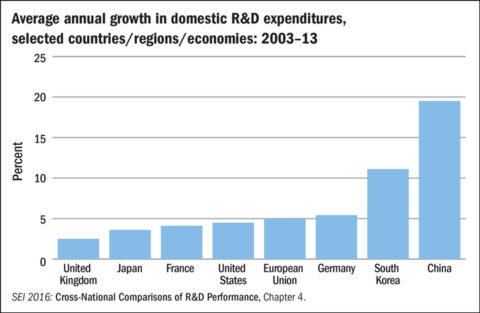The United States continues to lead the world in expenditures for research and development, but the number 2 spender, China, is increasing its investment in those areas at the fastest pace of any nation, states the newest issue of a biennial report released Tuesday. China is strengthening its research enterprise in other ways as well, such as making huge strides in graduating science and engineering degree recipients, according to the report, which relies mostly on data through 2013.

The United States accounted for 27% of global research and development (R&D) spending in 2013 and China for 20%, according to the report, which states that global R&D expenditures in 2013 were nearly $1.7 trillion, up from $836 billion a decade earlier.
A “multipolar world” for science and engineering “is emerging after many decades of leadership by the United States, the European Union, and Japan,” states the report, entitled “Science and Engineering Indicators 2016,” which is a biennial analysis issued by the U.S. National Science Board (NSB). The report provides key information about how the United States compares with other nations in the areas of research and development; science, technology, engineering, and math (STEM) education; and workforce development. The report also surveys public attitudes toward science.
Increased International Competition
“While international competition is growing, [U.S.] federal support for R&D is wavering,” said NSB vice-chair Kelvin Droegemeier, vice president for research at the University of Oklahoma in Norman, during a Tuesday briefing by telephone to release the report.
“There is plenty of room for lots of players,” said the National Science Board’s vice-chair. “It’s really about U.S. competitiveness and making sure that we remain competitive.”
“There is plenty of room for lots of [international] players,” he said. “It’s really about U.S. competitiveness and making sure that we remain competitive. We have to continue investing, [but] not at the same rate. We’ve got to continue speeding up and accelerating our investments and upping our game.”
There is “continuing evidence” of budget pressures on total R&D, particularly in the last 3–5 years, and “total federal R&D investments have not kept up with inflation,” said NSB chair Dan Arvizu, director of the U.S. Department of Energy’s National Renewable Energy Laboratory in Golden, Colo.
In 2013, U.S. R&D expenditures totaled $456 billion, with the private sector accounting for more than two thirds of that amount; 80% of U.S. R&D funding went to development and applied research and 18% to basic research, according to the report. About 40% of the U.S. gross domestic product derives from high-technology manufacturing and “knowledge-intensive service industries,” the report continues.
The report also focuses on the increased cost of attending public research universities. Net tuition and fees for full-time students rose 80% between 1999 and 2012 in the most research-intensive public universities while state and local appropriations fell 36% per student, according to the report. “We see now that budget constraints have substantially affected federally funded higher education R&D,” Droegemeier said.
Although the report does not delve too specifically into funding trends for the Earth and space sciences, Droegemeier said that “the lack of predictability in funding is, I think, more important an issue than the actual amounts.” He said, “Those areas in particular that are heavily dependent on observing systems that are very expensive really would benefit from having more predictability in their funding cycle.”
Public Attitudes Toward Science
The report details public attitudes toward science, showing that the public has more confidence in the scientific community than in any other institutions surveyed aside from the military and that about 55% of Americans worry “a great deal” or a “fair amount” about global warming or climate change.
In an interview with Eos, Arvizu said that responses about climate change often depend on what question is asked and on other factors such as the economy. “If unemployment is low, people have more interest in the environment. When unemployment is high, they have less interest in the environment.”
Arvizu said he was surprised by the results of a survey question that show that 51% of Americans believe that science makes life change too quickly, a percentage that is up about one third from a decade ago.
“What we found is those with less education and less income were more likely to express worry about the pace of change,” Arvizu said. Leaders in the scientific community “definitely need to be worried” about this perception, he added, because the nation needs a science- and technology-savvy population to thrive in today’s advanced society and to maintain its research and development leadership.
“We can’t leave large portions of our society underserved, and education is the key,” he said. “We have all this technology that is driving the pace of change. Simply to be competitive, I think we need a much more literate general population.”
—Randy Showstack, Staff Writer
Citation: Showstack, R. (2016), United States still first in science, tech research spending, Eos, 97, https://doi.org/10.1029/2016EO044219. Published on 22 January 2016.
Text © 2016. The authors. CC BY-NC 3.0
Except where otherwise noted, images are subject to copyright. Any reuse without express permission from the copyright owner is prohibited.

